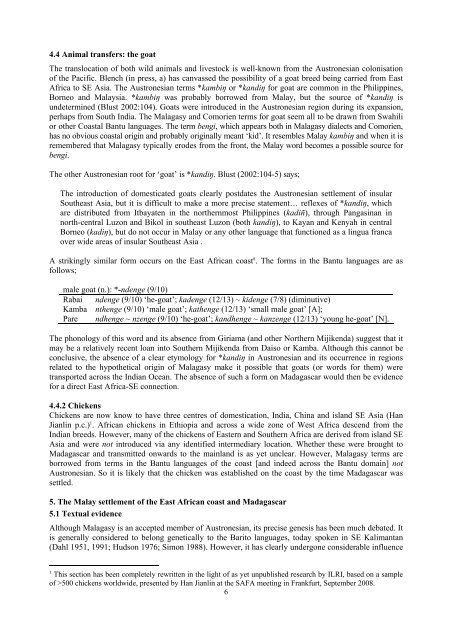Paper for Cambridge 2007 proceedings submit.pdf - Roger Blench
Paper for Cambridge 2007 proceedings submit.pdf - Roger Blench
Paper for Cambridge 2007 proceedings submit.pdf - Roger Blench
You also want an ePaper? Increase the reach of your titles
YUMPU automatically turns print PDFs into web optimized ePapers that Google loves.
4.4 Animal transfers: the goat<br />
The translocation of both wild animals and livestock is well-known from the Austronesian colonisation<br />
of the Pacific. <strong>Blench</strong> (in press, a) has canvassed the possibility of a goat breed being carried from East<br />
Africa to SE Asia. The Austronesian terms *kambiŋ or *kandiŋ <strong>for</strong> goat are common in the Philippines,<br />
Borneo and Malaysia. *kambiŋ was probably borrowed from Malay, but the source of *kandiŋ is<br />
undetermined (Blust 2002:104). Goats were introduced in the Austronesian region during its expansion,<br />
perhaps from South India. The Malagasy and Comorien terms <strong>for</strong> goat seem all to be drawn from Swahili<br />
or other Coastal Bantu languages. The term bengi, which appears both in Malagasy dialects and Comorien,<br />
has no obvious coastal origin and probably originally meant ‘kid’. It resembles Malay kambiŋ and when it is<br />
remembered that Malagasy typically erodes from the front, the Malay word becomes a possible source <strong>for</strong><br />
bengi.<br />
The other Austronesian root <strong>for</strong> ‘goat’ is *kandiŋ. Blust (2002:104-5) says;<br />
The introduction of domesticated goats clearly postdates the Austronesian settlement of insular<br />
Southeast Asia, but it is difficult to make a more precise statement… reflexes of *kandiŋ, which<br />
are distributed from Itbayaten in the northernmost Philippines (kadiñ), through Pangasinan in<br />
north-central Luzon and Bikol in southeast Luzon (both kandíŋ), to Kayan and Kenyah in central<br />
Borneo (kadiŋ), but do not occur in Malay or any other language that functioned as a lingua franca<br />
over wide areas of insular Southeast Asia .<br />
A strikingly similar <strong>for</strong>m occurs on the East African coast 8 . The <strong>for</strong>ms in the Bantu languages are as<br />
follows;<br />
male goat (n.): *-ndenge (9/10)<br />
Rabai ndenge (9/10) ‘he-goat’; kadenge (12/13) ~ kidenge (7/8) (diminutive)<br />
Kamba nthenge (9/10) ‘male goat’; kathenge (12/13) ‘small male goat’ [A];<br />
Pare ndhenge ~ nzenge (9/10) ‘he-goat’; kandhenge ~ kanzenge (12/13) ‘young he-goat’ [N].<br />
The phonology of this word and its absence from Giriama (and other Northern Mijikenda) suggest that it<br />
may be a relatively recent loan into Southern Mijikenda from Daiso or Kamba. Although this cannot be<br />
conclusive, the absence of a clear etymology <strong>for</strong> *kandiŋ in Austronesian and its occurrence in regions<br />
related to the hypothetical origin of Malagasy make it possible that goats (or words <strong>for</strong> them) were<br />
transported across the Indian Ocean. The absence of such a <strong>for</strong>m on Madagascar would then be evidence<br />
<strong>for</strong> a direct East Africa-SE connection.<br />
4.4.2 Chickens<br />
Chickens are now know to have three centres of domestication, India, China and island SE Asia (Han<br />
Jianlin p.c.) 1 . African chickens in Ethiopia and across a wide zone of West Africa descend from the<br />
Indian breeds. However, many of the chickens of Eastern and Southern Africa are derived from island SE<br />
Asia and were not introduced via any identified intermediary location. Whether these were brought to<br />
Madagascar and transmitted onwards to the mainland is as yet unclear. However, Malagasy terms are<br />
borrowed from terms in the Bantu languages of the coast [and indeed across the Bantu domain] not<br />
Austronesian. So it is likely that the chicken was established on the coast by the time Madagascar was<br />
settled.<br />
5. The Malay settlement of the East African coast and Madagascar<br />
5.1 Textual evidence<br />
Although Malagasy is an accepted member of Austronesian, its precise genesis has been much debated. It<br />
is generally considered to belong genetically to the Barito languages, today spoken in SE Kalimantan<br />
(Dahl 1951, 1991; Hudson 1976; Simon 1988). However, it has clearly undergone considerable influence<br />
1 This section has been completely rewritten in the light of as yet unpublished research by ILRI, based on a sample<br />
of >500 chickens worldwide, presented by Han Jianlin at the SAFA meeting in Frankfurt, September 2008.<br />
6

















